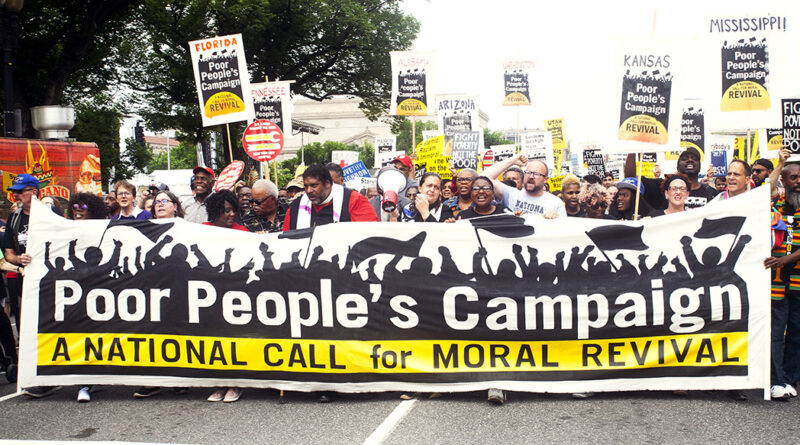Dayton and Ohio are part of the Poor People’s Campaign to mobilize voters ahead of November election
Pictured is protestors for the Poor People’s Campaign. Photo courtesy of André Daughtry for April.
Elizabeth Barker | Contributing Writer
COLUMBUS, Ohio – Ohio was one of 30 states where mass assemblies took place earlier this month at statehouses as part of the Poor People’s Campaign, which launched in February to mobilize 15 million poor and low-wage voters ahead of the November presidential election.
Ohio’s part in the March 2 assembly at the statehouse in Columbus is tri-chaired by Clair Hochstetler, David Guran, and the Rev. Dr. Jack Sullivan.
“Poor and low-wage voters, faith leaders, and social justice advocates gathered to declare their votes and demands for living wages, voting rights, and other policies to combat poverty and save lives,” according the Columbus Free Press.
The assembly in Ohio was part of a 40-week effort to mobilize poor and low-wage voters in Ohio and demand that legislators take action to end the crisis of death by poverty in the United States.
The Poor People’s Campaign, also known as the Poor People’s March, started in 1967 when the Rev. Dr. Martin Luther King Jr. and the Southern Christian Leadership Conference met and discussed employment and housing issues among the poor throughout the United States. The campaign’s goal was to demand that the federal government find solutions to the economic inequalities facing the poor and that it would be the most sustainable, massive, and widespread effort of civil disobedience undertaken by any social movement in U.S. history.
The national Poor People’s campaign is an extension of MLK’s movement, which is headed today by the Rev. Dr. William J. Barber II and the Rev. Liz Theoharis. The campaign works to have distinct state campaigns and non-violent marches that aim to “challenge the evils of systemic racism, poverty, the war economy, ecological devastation, and the nation’s distorted moral narrative of religious nationalism,” according to The Poor People’s Campaign website.
“Poor and low-wage voters have the power to change electoral outcomes up and down the ballot in November,” Barber told the Columbus Free Press. “We are putting politicians on notice: if you want our votes, you must legislate to end the crisis of death by poverty in America.”
David Guran, tri-chair of Ohio’s campaign, spoke about the assembly in Columbus.
“We had 10 speakers who are poor or low-income people,” Guran said. “They gave testimony on their experience with state policies that make their lives more difficult just because they are poor.”
The assembly also featured six faith leaders who shared their perspectives on poor and low-income people who are affected by public policy.
Guran shared that the feedback from the assembly was positive.
“Comments that we received from attendees and viewers expressed their excitement to get involved with our movement to mobilize people to vote,” Guran said.
According to the Poor People’s Campaign fact sheet, Ohio is home to 4.06 million poor and low-income eligible voters who make up 39.55% of the electorate. The campaign says that a key factor that discourages poor and low-income people from voting is political campaigns that don’t speak to their issues. All states participating in the campaign have the same general demands.
Peggy Ann Berry, a Daytonian and part of the movement, became involved in the Ohio Poor People’s Campaign (OHPPC) through a mutual friend.
“The fact that it was an extension of the Martin Luther King movement fascinated me,” Berry said. “I ended up on their coordination committee for about two years and was a fiscal sponsor for about as long through my non-profit Between the Waters. I felt the two complimented each other related to the overwhelming oppression of BIPOC communities on water issues.”
Berry said although Dayton specifically is not as active as the Cincinnati area, five people from Dayton attended the mass assembly in Columbus. Dayton has since moved into the Southwest group of the Ohio campaign.
Berry also shared some of what goes into coordinating Ohio’s part of the campaign.
“We work to create actions and enthusiasm through acceptance that we are all equal, no matter how much we do and don’t make or do for a living,” Berry said. “And, we don’t get anywhere without money. We fundraise.”
On March 4, campaign advocates reconvened at Ohio legislative offices in Columbus and delivered a letter that communicated the conditions poor people in Ohio are facing and how they want these crises addressed.
“We informed the legislators and/or their staffers about the Poor People’s Campaign in general to begin discussions with policymakers,” Guran said. “We presented the demands of our movement.”
For the next 40 weeks leading up to the November election, Guran said the OHPPC will continue to engage in conversations with poor and low-income people in their communities.
For those at the University of Dayton, in the Miami Valley, or anywhere in the surrounding area looking to join the OHPPC, go to https://www.poorpeoplescampaign.org/committee/ohio/ to learn more.

